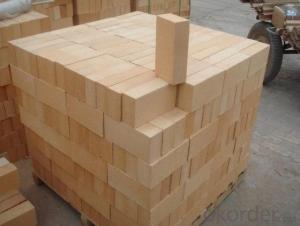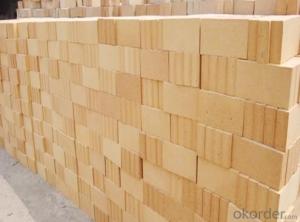Refractory Brick/Refractory Magnesia-Pleonaste/Refracory Lining of Cement Plant
- Loading Port:
- China main port
- Payment Terms:
- TT OR LC
- Min Order Qty:
- 20 m.t.
- Supply Capability:
- 2000 m.t./month
OKorder Service Pledge
OKorder Financial Service
You Might Also Like
CNBM conforms strictly to the requirements of ISO 9000 quality control system during the production. MSDS is also available if you want. The thermal insulation fire clay brick meet with the requirements of ASTM & JIS standards. So pls stay cool with our quality.
Insulating Fire Brick Technical index
Product No. | IFB70 | IFB60 | IFB50 | IFB40 |
Al2O3 | 68%-72% | 58%-62% | 48%-52% | 38%-40% |
Refractoriness (°C ) | ≥1790 | ≥1790 | ≥1790 | ≥1790 |
Bulk density (g/cm3) | 2.50-2.60 | 2.35-2.45 | 2.20-2.30 | 2.10-2.20 |
Apparent porosity (%) | 22 | 19-22 | 17-20 | 17-20 |
Cold Crushing strength (kg) | 480-510 | 450-480 | 430-450 | 390-430 |
Application
Insulating Fire Brick are used for the lining of converter, alternating current arc furnace, direct Current arc furnace and the ladle slag line, etc.
Equipment
1 unit of Ceramic Abrasive (SG Abrasive) pilot production line
2 units of Compact grain Abrasive pilot production lines
1 unit of high-end coated abrasives (abrasive cloth) production line
Company Advantage
(1)Long Insulating Fire Brick manufacture history: 25 years manufacturer
(2)Advanced equipment
(3)Diversification of production standards: ISO ANSI FEPA JIS ASTM
(4)Flexible payment: T/T L/C D/P D/A
(5)Professional marketing team and after-sale service
(6)Free sample
FAQs
Q1 |
What’s the transport method? |
A1 | FCL delivery goods with wooden pallet or wooden case by sea; If LCL delivery, must with wooden case; Sometimes need open top, flat rack or bulk cargo. |
Q2 |
What’s the required payment term? |
A2 | Generally 30% TT as the prepayment, 70% TT before delivery. If need, 100% Irrevocable Letter of Credit or negotiation. |
Q3 |
Which country are our products exported to? |
A3 | Apart from entire Chinese market, the US, Russia, Japan, Korea, Australia and some Southeast Asian Nations. |
- Q:Do insulating fire bricks require regular maintenance?
- Insulating fire bricks are engineered to endure high temperatures and resist deterioration, thereby obviating the need for routine upkeep. Crafted from robust materials with exceptional insulating capabilities, they are impervious to wear and tear. Nevertheless, a periodic examination to detect any cracks, chips, or indications of impairment is imperative. In the event that damage is discovered, immediate repairs are essential to guarantee the bricks' optimal functionality. Moreover, regular cleansing of the bricks aids in the elimination of debris or residue accumulation, which can impede their insulating qualities. In summary, although infrequent maintenance is required for insulating fire bricks, periodic inspections and intermittent cleansing are advised to uphold their durability and efficacy.
- Q:Do insulating fire bricks require special installation techniques?
- Yes, insulating fire bricks do require special installation techniques. These bricks are designed to withstand high temperatures and provide insulation, so proper installation is crucial to ensure their effectiveness. Special attention needs to be given to factors such as mortar selection, brick alignment, and proper curing to achieve optimal thermal performance.
- Q:Do insulating fire bricks require any special firebrick mortar for installation?
- Yes, insulating fire bricks do require a special firebrick mortar for installation. These bricks have a lower density and higher insulating properties, so using a regular mortar can compromise their performance. It is recommended to use a specialized firebrick mortar that can withstand high temperatures and bond effectively with the insulating fire bricks to ensure a proper and durable installation.
- Q:Can insulating fire bricks be used in the construction of smelting crucibles?
- Certainly, one can utilize insulating fire bricks in the construction of smelting crucibles. These bricks have been specifically designed to endure high temperatures and offer exceptional insulation. They find wide usage in various applications that demand heat retention and protection, such as kilns and furnaces. Smelting crucibles, which are employed for the purpose of melting and refining metals, also necessitate materials capable of withstanding extreme temperatures. Insulating fire bricks prove to be an ideal selection for constructing smelting crucibles due to their ability to sustain a consistent temperature within the crucible and prevent heat loss. Furthermore, their insulating properties contribute to reduced energy consumption and heightened efficiency in the smelting process.
- Q:Can insulating fire bricks be used in residential construction?
- Yes, insulating fire bricks can be used in residential construction. They are commonly used to line fireplaces, wood-burning stoves, and other heating appliances in homes. These bricks are designed to withstand high temperatures and provide excellent thermal insulation, making them suitable for residential applications where heat retention and fire protection are important factors.
- Q:Are insulating fire bricks resistant to thermal stress?
- Yes, insulating fire bricks are resistant to thermal stress. These bricks are specially manufactured to withstand high temperatures and thermal fluctuations without cracking or breaking. They are made from refractory materials that have excellent thermal insulation properties and can handle extreme heat conditions. Insulating fire bricks have low thermal conductivity, meaning they can effectively resist heat transfer and maintain their structural integrity even when exposed to rapid temperature changes. They are commonly used in applications such as kilns, furnaces, and fireplaces, where thermal stress is a significant concern. Overall, insulating fire bricks are designed to provide reliable and durable insulation while withstanding the thermal stress associated with high-temperature environments.
- Q:Can insulating fire bricks be used in outdoor applications?
- Insulating fire bricks are specifically designed for high-temperature applications and are commonly used in indoor environments such as kilns, furnaces, and ovens. While they are not typically recommended for outdoor applications, there are certain circumstances where they can be used with caution. Insulating fire bricks are made from lightweight refractory materials that provide excellent insulation and heat resistance. However, they are not as durable or weather-resistant as other types of bricks, such as clay or concrete bricks, which are more suitable for outdoor use. In outdoor applications, insulating fire bricks may be exposed to harsh weather conditions, including rain, snow, extreme temperatures, and UV radiation, which can cause them to deteriorate and lose their insulating properties over time. Additionally, these bricks are more susceptible to cracking and damage due to thermal expansion and contraction caused by temperature fluctuations. If you need to use insulating fire bricks in an outdoor application, it is important to take extra precautions to protect them from the elements. This can include using weatherproof coatings or sealants to minimize water absorption and prevent damage from freezing and thawing cycles. It is also crucial to ensure proper drainage and ventilation to prevent moisture accumulation, as excessive moisture can compromise the insulation properties of these bricks. Overall, while insulating fire bricks can be used in outdoor applications under specific conditions, it is generally recommended to use more suitable materials for long-term durability and performance.
- Q:Can insulating fire bricks be used in refractory lining applications?
- Yes, insulating fire bricks can be used in refractory lining applications. Insulating fire bricks are made from lightweight materials that have high insulating properties, such as clay or silica. These bricks are designed to provide excellent thermal insulation, reducing heat loss and improving energy efficiency in high-temperature applications. In refractory lining applications, insulating fire bricks are commonly used to line the walls, floors, and roofs of furnaces, boilers, kilns, and other industrial equipment. They are effective in preventing heat transfer to the surrounding environment and maintaining the desired temperature inside the equipment. Insulating fire bricks are also resistant to thermal shock, meaning they can withstand rapid changes in temperature without cracking or failing. This makes them suitable for applications where the equipment goes through frequent heating and cooling cycles. Furthermore, insulating fire bricks have low thermal conductivity, which means they can effectively limit heat transfer between different areas of the refractory lining. This helps to prevent hot spots and temperature imbalances, ensuring uniform heat distribution throughout the equipment. Overall, insulating fire bricks are a versatile and effective choice for refractory lining applications, providing excellent thermal insulation, resistance to thermal shock, and uniform heat distribution.
- Q:Are insulating fire bricks suitable for use in the construction of incinerators?
- Yes, insulating fire bricks are suitable for use in the construction of incinerators. Insulating fire bricks have excellent thermal insulation properties, allowing them to withstand high temperatures and efficiently retain heat. This makes them ideal for lining the walls and floors of incinerators, as they help to contain and direct heat, ensuring proper combustion while reducing heat loss. Additionally, insulating fire bricks are resistant to chemical attacks and can withstand the corrosive environment found in incinerators, making them a reliable choice for this application.
- Q:Is it necessary to use mortar when installing insulating fire bricks?
- Yes, it is necessary to use mortar when installing insulating fire bricks. Mortar acts as a bonding agent between the bricks, ensuring stability and preventing heat loss. It also helps to seal any gaps or cracks, enhancing the insulation properties of the bricks.
1. Manufacturer Overview |
|
|---|---|
| Location | |
| Year Established | |
| Annual Output Value | |
| Main Markets | |
| Company Certifications | |
2. Manufacturer Certificates |
|
|---|---|
| a) Certification Name | |
| Range | |
| Reference | |
| Validity Period | |
3. Manufacturer Capability |
|
|---|---|
| a)Trade Capacity | |
| Nearest Port | |
| Export Percentage | |
| No.of Employees in Trade Department | |
| Language Spoken: | |
| b)Factory Information | |
| Factory Size: | |
| No. of Production Lines | |
| Contract Manufacturing | |
| Product Price Range | |
Send your message to us
Refractory Brick/Refractory Magnesia-Pleonaste/Refracory Lining of Cement Plant
- Loading Port:
- China main port
- Payment Terms:
- TT OR LC
- Min Order Qty:
- 20 m.t.
- Supply Capability:
- 2000 m.t./month
OKorder Service Pledge
OKorder Financial Service
Similar products
New products
Hot products
Hot Searches
Related keywords



























